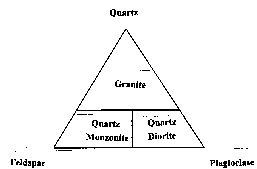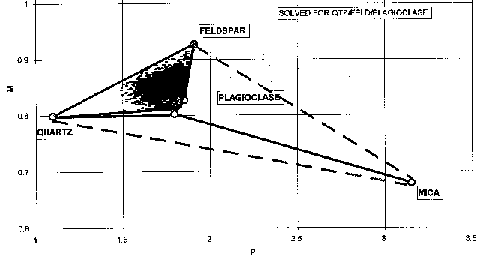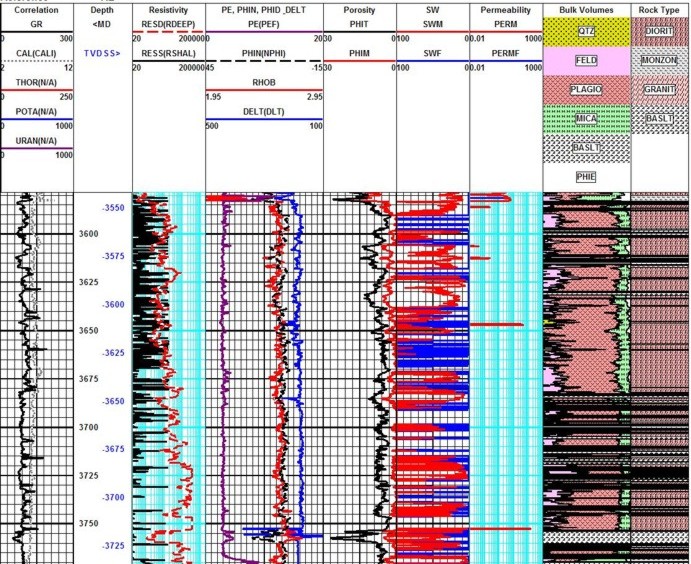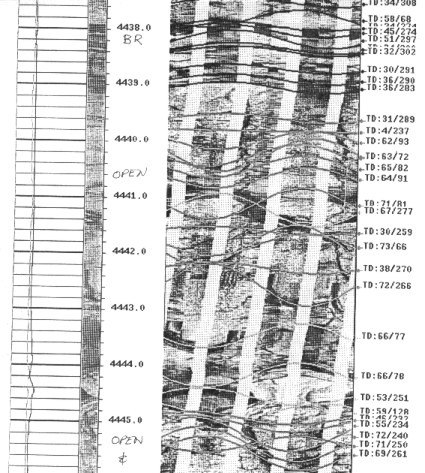|
 CaSE HISTORY - FRACTURED GRANITE Reservoir
CaSE HISTORY - FRACTURED GRANITE Reservoir
Most people
forget that there are many unconventional reservoirs in the
world, including igneous, metamorphic, and volcanic rocks.
Granite reservoirs are prolific in Viet Nam, Libya, and
Indonesia. Lesser known granite reservoirs exist in
Venezuela, United States, Russia, and elsewhere. Indonesia
is blessed with a combination sedimentary, metamorphic, and
granite reservoir with a single gas leg. Japan boasts a
variety of volcanic reservoirs.
This
example is from the Bach Ho (White Tiger) Field in Viet Nam.
Log
analysis in these reservoirs requires good geological input as to
mineralogy, oil or gas shows, and porosity. A good coring and sample
description program is essential, and production tests are
essential. The analyst often has to separate ineffective
(disconnected vugs) from effective porosity and account for fracture
porosity and permeability. All the usual mineral identification
crossplots are useful but the mineral mix may be very different than
normal reservoirs. Many such reservoirs seem to have no water zone
and most have unusual electrical properties (A, M, N), so capillary
pressure data is usually needed to calibrate water saturation.
Because
the porosity is usually low and mineral mix quite variable, the key
to a good fractured reservoir analysis is careful attention to both
calculations, as described below.

Ternary
Diagram for Granite 
In the
example below, the granitic mineral assemblage was defined by the
ternary diagram at right. The three minerals (quartz, feldspar, and
plagioclase) were computed from a modified Mlith vs Nlith model, in
which PE was substituted for PHIN in the Nlith equation. If data
fell too far outside the triangle, mica was exchanged for the
quartz.
Three
rock types, granite, diorite, and monzonite, were derived from the
three minerals. A trigger was set to detect basalt intrusions. A
sample crossplot below shows how the lithology model effectively
separates the minerals.

Mlith vs Plith crossplot for
granite (micaceous data excluded)

Raw data curves are
shown in Tracks 1, 2, and 3 with porosity, water saturation, and
permeability in Tracks 4, 5, and 6. The mineral model calculated
from the log analysis is in Track 7 and the rock type model
calculated from the minerals using the ternary diagram is in Track
8. Basalt was triggered from high density or high PE or both.
Effective porosity (PHIT on log heading) and matrix porosity (PHIM)
were calculated from the Aquilera dual porosity model. The
difference between them is the sum of solution and fracture
porosity.
To test the
mineral model and as preparation for calculating the partitioning
factor for the dual porosity model, neutron, density, and sonic
matrix values, corrected for mineral composition as determined
above, were calculated. Neutron, sonic and density porosity were
re-calculated using these matrix values..
Total porosity (PHIt) was taken from the neutron porosity. Neutron
and density were corrected for ineffective matrix porosity,
typically 2% for neutron and 5% for density, by comparing log
analysis results to available core data. Matrix porosity (PHIm) was
then computed from the neutron density crossplot.
Fracture
porosity (PHIf) was calculated from the difference between total and
matrix porosity. Porosity partitioning coefficient (V) was computed
from the ratio of fracture porosity to total porosity. A maximum
limit of 0.4% was assumed for fracture porosity. Effective porosity
was calculated as the sum of effective matrix and fracture porosity.
Combined M
for water saturation (Md) was calculated from the
partitioning coefficient and the Aguilera formulae. Fracture water
saturation was calculated based on oil and water viscosity and oil
formation volume factor. Matrix permeability was calculated from an
equation based on core (matrix) porosity versus permeability.
Fracture permeability was calculated from fracture porosity assuming
a constant aperture of 0.2 mm.
Fracture
porosity from resistivity micro scanner logs was also computed where
available to help control the open hole work. A black and white
resistivity image log below shows some of the fractures. Both high
and low angle fractures co-exist.

Resistivity micro scanner image
in granite reservoir
|

